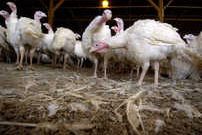



"Humane" Livestock Production Costs Hard to Gauge
KANSAS CITY - Whether animal rights activists or livestock producers and processors are right in the dispute over animal rights and humane treatment comes down to whose ox is being gored.
One difficult question to answer is just how much it will cost the livestock and poultry industries to change production methods. And, in the longer run, how much of these costs will be passed on to the consumer?
The rhetoric by both sides clouds the issue. Animal activists demand that laws be passed to change the conditions under which livestock and poultry are raised. The livestock sector argues that the changes the activists want will increase production costs and that some of the alternative programs they want are inhumane as well.
The Humane Society of the United States is initiating a petition drive to put an initiative on the California ballot that would ban gestation crates for sows, battery cages for laying hens and veal crates for veal calves. A San Francisco Bay area group called East Bay Animal Advocates is an on-the-ground group working to aid in the effort.
Christine Morrissey, director of East Bay Animal Advocates, said supporters have 150 days beginning Oct. 1 to gather the minimum 433,000 valid signatures necessary for voters to weigh in on the issue. She said organizers would try to gather 620,000 to 630,000 signatures.
Morrissey said there are nearly 20 million laying hens in the state and 15,000 to 20,000 sows that would be affected. Veal crates are going out of style across the country, but this would block their reintroduction if they ever became popular among producers again, Morrissey said.
As alternatives to battery cages and gestation crates, Morrissey suggested cage-free and free-range methods of raising laying hens and group housing for sows. Some California producers already are using these methods, she said. However, she acknowledged that the alternative practices would raise production costs.
Production costs will go up, Morrissey said, and the burden is on producers and on consumers. But consumers will have the advantage of not eating food that is produced under the currently predominating methods, she said.








